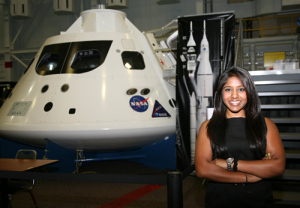This summer marks the beginning of a new chapter for Priyanka Cholleti, a graduate student in the University of Houston aerospace engineering program. She will soon receive a master of science in aerospace engineering, but before that happens, she must complete her internship at NASA Johnson Space Center.
She is in no hurry to leave.
Working at NASA is, for Cholleti, more than just an internship. It’s the realization of a lifelong goal. “Ever since I was young, I wanted to be an astronaut,” Cholleti said. She recalled an event from her past, specifically fifth grade, in which she participated in a young astronauts program. She was part of a group of seven other aspiring astronauts who were on a voyage to Mars. They communicated with “mission control” via video conference, while conducting experiments.
Cholleti recalled, “We had suits and helmets, and we walked through the school on mission day, and that’s when I thought, ‘This is what I want to do.’”
As a graduate student, she was thrilled to get the offer from NASA to research fluid dynamics. Her primary task is to study the various forces and load distributions upon re-entry of the Orion capsule.
Previously, she had conducted research on wind turbines with mechanical engineering professor Ralph Metcalfe, and her knowledge in that area gave her a boost in the area of fluid dynamics.
Upon arrival at NASA, there was much to learn. Namely, programming.
“When I joined NASA, I hadn’t used the program for coding language so when I got here, I learned C++ and Python,” Cholleti said. “I had to know those programs in order to learn the software they wanted me to use. It was super challenging.”
Steve Fitzgerald, Cholleti’s NASA supervisor, left her to her own devices, and it worked. Cholleti, who was new to parallel computing, taught herself open-source code to run simulations, essentially creating a program to feed into NASA’s own computational fluid dynamics (CFD) solvers. She created a model and simulation of a wave tank, incorporating paddles to create different types of waves.
For Cholleti, the opportunity to explore and learn is priceless. “I’ve always felt that engineering was awesome. I’ve always loved creating new things and being able to apply knowledge. Engineering is everywhere - that’s what got me.”
Cholleti was pleasantly surprised by the work culture at NASA Johnson Space Center, where she hopes to remain on a full time basis beyond the end of her internship. “It’s like a family - it’s an amazing place to work,” she said. “As soon as you walk in, everyone’s super-friendly and willing to help you.”
Cholleti’s work in fluid dynamics is an example of the flexibility of the aerospace engineering program at UH. The degree plan can be customized to fit the interests of the student. Because it is interdisciplinary, students gain knowledge in various areas of engineering, from subsea to wind energy. There are abundant opportunities to specialize in particular areas, and internships in the Houston area allow students to apply research skills that solve problems.
Cholleti advises new engineering students, both graduate and undergrad, to “make the most of it. Get to know all your professors and what they’re working on because UH is doing some crazy-awesome things. Find your interest and do internships along the way, because it’s fun and challenging working in a real-life engineering environment.”
The University of Houston aerospace engineering program offers M.S. and Ph.D. degrees. Bonnie Dunbar, retired astronaut, professor of mechanical engineering and biomedical engineering and head of the UH STEM Center, was recently appointed as the program’s new director.
